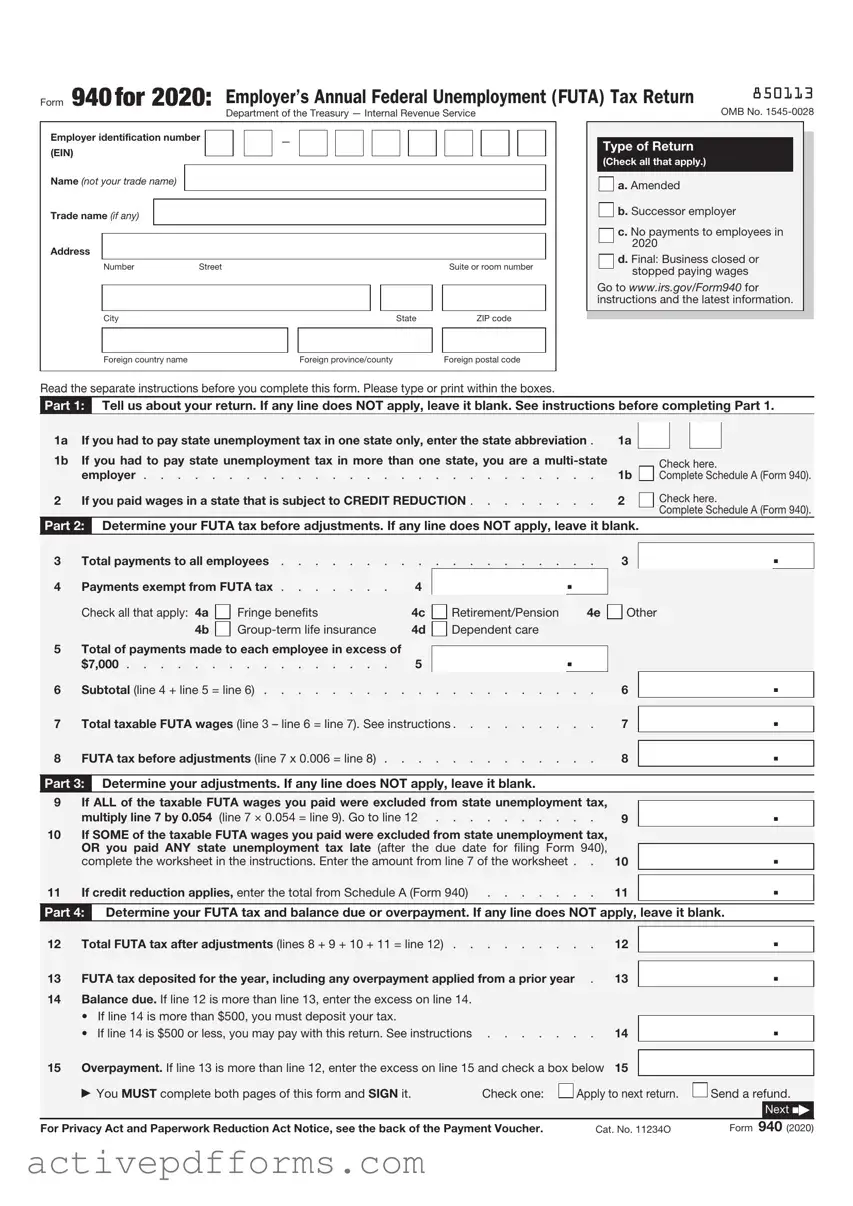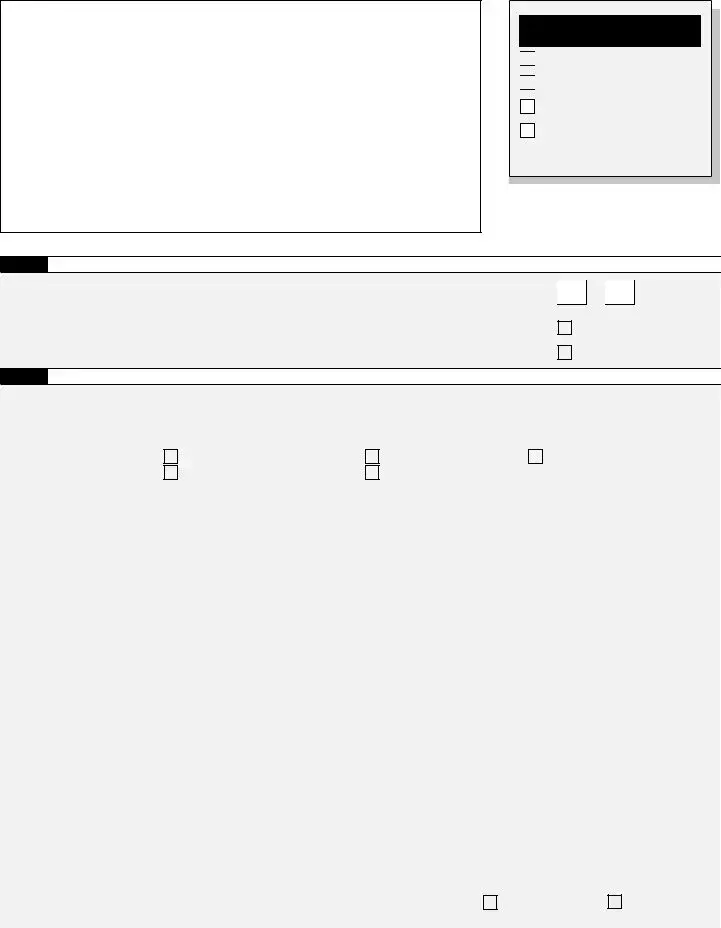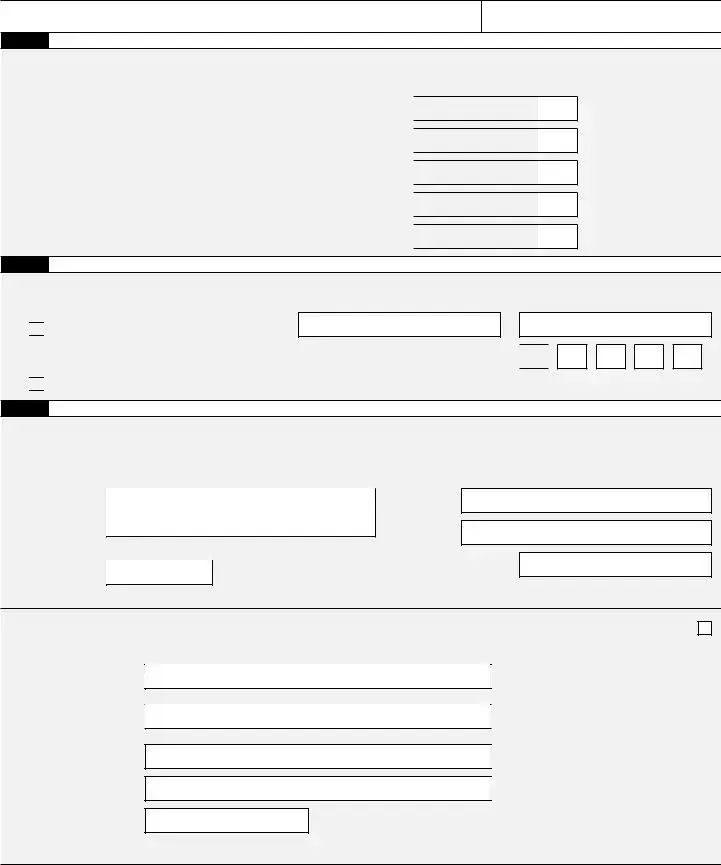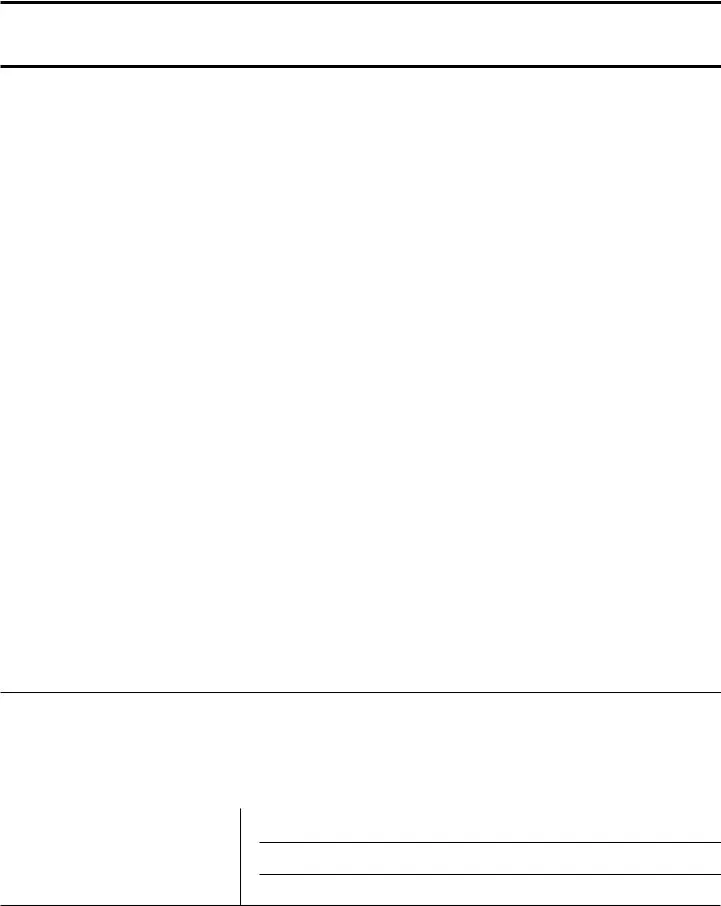|
Form 940for 2020: Employer’s Annual Federal Unemployment (FUTA) Tax Return |
850113 |
|
OMB No. 1545-0028 |
|
Department of the Treasury — Internal Revenue Service |
Employer identification number |
|
|
|
— |
|
|
|
|
|
|
|
|
|
|
|
|
|
(EIN) |
|
|
|
|
|
|
|
|
|
|
|
|
|
|
|
|
|
|
|
|
|
|
|
|
|
|
|
|
|
|
|
|
|
|
|
|
|
|
|
|
|
|
|
|
|
|
|
|
|
|
|
|
|
|
Name (not your trade name) |
|
|
|
|
|
|
|
|
|
|
|
|
|
|
|
|
|
|
|
|
|
|
|
|
|
|
|
|
|
|
|
|
|
|
|
|
|
|
|
|
|
|
|
|
|
|
|
|
|
|
|
|
|
|
|
|
|
|
|
Trade name (if any) |
|
|
|
|
|
|
|
|
|
|
|
|
|
|
|
|
|
|
|
|
|
|
|
|
|
|
|
|
|
|
|
|
|
|
|
|
|
|
|
|
|
|
|
|
|
|
|
|
|
|
|
|
|
|
|
|
|
Address |
|
|
|
|
|
|
|
|
|
|
|
|
|
|
|
|
|
|
Number |
Street |
|
|
|
|
Suite or room number |
|
|
|
|
|
|
|
|
|
|
|
|
|
|
|
|
City |
|
|
|
|
State |
|
ZIP code |
|
|
|
|
|
|
|
|
|
|
|
|
|
|
|
|
Foreign country name |
|
|
Foreign province/county |
|
Foreign postal code |
Type of Return
(Check all that apply.)

 a. Amended
a. Amended

 b. Successor employer
b. Successor employer
c. No payments to employees in 2020
d. Final: Business closed or stopped paying wages
Go to www.irs.gov/Form940 for instructions and the latest information.
Read the separate instructions before you complete this form. Please type or print within the boxes.
Part 1: Tell us about your return. If any line does NOT apply, leave it blank. See instructions before completing Part 1.
1a |
If you had to pay state unemployment tax in one state only, enter the state abbreviation . |
1a |
|
1b |
If you had to pay state unemployment tax in more than one state, you are a multi-state |
|
|
|
employer |
1b |
|
2 |
If you paid wages in a state that is subject to CREDIT REDUCTION |
2 |
|
|
Check here.
Complete Schedule A (Form 940).
Check here.
Complete Schedule A (Form 940).
Part 2: Determine your FUTA tax before adjustments. If any line does NOT apply, leave it blank.
3 |
Total payments to all employees |
. |
3 |
|
|
|
|
. |
4 |
Payments exempt from FUTA tax |
4 |
|
|
|
. |
|
|
|
|
|
|
|
|
|
|
|
|
|
|
|
|
|
|
|
|
|
|
|
|
|
Check all that apply: 4a |
|
Fringe benefits |
4c |
|
Retirement/Pension |
4e |
|
Other |
|
|
|
|
|
|
4b |
|
Group-term life insurance |
4d |
|
Dependent care |
|
|
|
|
|
|
|
|
|
|
|
|
|
|
|
|
|
|
|
|
5 |
Total of payments made to each employee in excess of |
|
|
|
|
|
|
|
|
|
|
|
|
|
|
|
|
|
|
. |
|
|
|
|
|
|
|
|
|
$7,000 |
5 |
|
|
|
|
|
|
|
|
|
|
|
6 |
Subtotal (line 4 + line 5 = line 6) |
. |
6 |
|
|
|
. |
|
|
|
|
|
|
|
|
7 |
Total taxable FUTA wages (line 3 – line 6 = line 7). See instructions |
. |
7 |
|
|
|
|
. |
|
|
|
|
|
|
|
|
8 |
FUTA tax before adjustments (line 7 x 0.006 = line 8) |
. |
8 |
|
|
|
|
. |
|
|
|
|
|
|
|
|
|
|
|
|
|
|
|
|
|
|
|
Part 3: |
Determine your adjustments. If any line does NOT apply, leave it blank. |
|
|
|
|
|
|
|
|
9 |
If ALL of the taxable FUTA wages you paid were excluded from state unemployment tax, |
|
|
|
|
|
|
|
|
|
|
|
|
|
. |
|
multiply line 7 by 0.054 |
(line 7 × 0.054 = line 9). Go to line 12 |
. |
9 |
|
|
|
10 |
If SOME of the taxable FUTA wages you paid were excluded from state unemployment tax, |
|
|
|
|
|
|
|
|
OR you paid ANY state unemployment tax late (after the due date for filing Form 940), |
|
|
|
|
|
|
. |
|
complete the worksheet in the instructions. Enter the amount from line 7 of the worksheet . |
. |
10 |
|
|
|
|
|
|
|
|
|
|
|
11 |
If credit reduction applies, enter the total from Schedule A (Form 940) |
. |
11 |
|
|
|
|
. |
|
|
|
Part 4: |
Determine your FUTA tax and balance due or overpayment. If any line does NOT apply, leave it blank. |
|
|
|
|
|
|
|
|
12 |
Total FUTA tax after adjustments (lines 8 + 9 + 10 + 11 = line 12) |
. |
12 |
|
|
|
|
. |
|
|
|
|
|
|
|
|
13 |
FUTA tax deposited for the year, including any overpayment applied from a prior year |
. |
13 |
|
|
|
|
. |
14 |
Balance due. If line 12 is more than line 13, enter the excess on line 14. |
|
|
|
|
|
|
|
|
|
• If line 14 is more than $500, you must deposit your tax. |
|
|
|
|
|
|
|
|
|
|
|
|
|
|
|
|
|
|
|
|
|
|
14 |
|
|
|
|
. |
|
• |
If line 14 is $500 or less, you may pay with this return. See instructions |
. |
|
|
|
|
|
|
|
|
|
|
15 |
Overpayment. If line 13 is more than line 12, enter the excess on line 15 and check a box below |
15 |
|
|
|
|
. |
|
|
You MUST complete both pages of this form and SIGN it. |
|
|
Check one: |
|
|
|
Apply to next return. |
|
Send a refund. |
|
|
|
|
|
|
|
|
|
|
|
|
|
|
|
|
|
|
|
|
|
|
|
|
|
|
|
|
|
|
|
|
|
|
|
|
|
Next N |
|
|
|
|
|
For Privacy Act and Paperwork Reduction Act Notice, see the back of the Payment Voucher. |
Cat. No. 11234O |
|
Form |
940 (2020) |
Name (not your trade name)
Employer identification number (EIN)
Part 5: Report your FUTA tax liability by quarter only if line 12 is more than $500. If not, go to Part 6.
16Report the amount of your FUTA tax liability for each quarter; do NOT enter the amount you deposited. If you had no liability for a quarter, leave the line blank.
16a |
1st quarter (January 1 – March 31) . . |
. . |
. |
. |
. |
. |
. |
16a |
16b |
2nd quarter (April 1 – June 30) . . . |
. . |
. |
. |
. |
. |
. |
16b |
16c |
3rd quarter (July 1 – September 30) . |
. . |
. |
. |
. |
. |
. |
16c |
16d |
4th quarter (October 1 – December 31) |
. . |
. |
. |
. |
. |
. |
16d |
17 Total tax liability for the year (lines 16a + 16b + 16c + 16d = line 17) 17
Total must equal line 12.
Part 6: May we speak with your third-party designee?
Do you want to allow an employee, a paid tax preparer, or another person to discuss this return with the IRS? See the instructions for details.

 Yes. Designee’s name and phone number
Yes. Designee’s name and phone number
Select a 5-digit personal identification number (PIN) to use when talking to the IRS. 


 No.
No.
Part 7: Sign here. You MUST complete both pages of this form and SIGN it.
Under penalties of perjury, I declare that I have examined this return, including accompanying schedules and statements, and to the best of my knowledge and belief, it is true, correct, and complete, and that no part of any payment made to a state unemployment fund claimed as a credit was, or is to be, deducted from the payments made to employees. Declaration of preparer (other than taxpayer) is based on all information of which preparer has any knowledge.
Print your name here
Print your title here
Best daytime phone
Paid Preparer Use Only
Preparer’s name
Preparer’s signature
Firm’s name (or yours if self-employed)
Address
City
Check if you are self-employed
|
|
PTIN |
|
|
|
|
|
|
|
|
|
|
|
Date |
/ |
/ |
|
|
|
EIN |
|
|
|
|
|
|
|
|
|
|
Phone |
|
|
|
|
|
|
|
|
State |
|
ZIP code |
|
|
|
|
|
|
|
Form 940-V, Payment Voucher
Purpose of Form
Complete Form 940-V if you’re making a payment with Form 940. We will use the completed voucher to credit your payment more promptly and accurately, and to improve our service to you.
Making Payments With Form 940
To avoid a penalty, make your payment with your 2020 Form 940 only if your FUTA tax for the fourth quarter (plus any undeposited amounts from earlier quarters) is $500 or less. If your total FUTA tax after adjustments (Form 940, line 12) is more than $500, you must make deposits by electronic funds transfer. See When Must You Deposit Your FUTA Tax? in the Instructions for Form
940.Also see sections 11 and 14 of Pub. 15 for more information about deposits.
Use Form 940-V when making any payment with F! Form 940. However, if you pay an amount with CAUTION Form 940 that should’ve been deposited, you
may be subject to a penalty. See Deposit Penalties in section 11 of Pub. 15.
Specific Instructions
Box 1—Employer identification number (EIN). If you don’t have an EIN, you may apply for one online by visiting the IRS website at www.irs.gov/EIN. You may also apply for an EIN by faxing or mailing Form SS-4 to the IRS. If you haven’t received your EIN by the due date of Form 940, write “Applied For” and the date you applied in this entry space.
Box 2—Amount paid. Enter the amount paid with Form 940.
Box 3—Name and address. Enter your name and address as shown on Form 940.
•Enclose your check or money order made payable to “United States Treasury.” Be sure to enter your EIN, “Form 940,” and “2020” on your check or money order. Don’t send cash. Don’t staple Form 940-V or your payment to Form 940 (or to each other).
•Detach Form 940-V and send it with your payment and Form 940 to the address provided in the Instructions for Form 940.
Note: You must also complete the entity information above Part 1 on Form 940.
|
Detach Here and Mail With Your Payment and Form 940. |
|
|
|
|
|
|
Form 940-V |
|
Payment Voucher |
|
OMB No. 1545-0028 |
|
|
|
|
|
|
|
|
|
|
|
|
|
|
Department of the Treasury |
|
Don’t staple or attach this voucher to your payment. |
|
2020 |
Internal Revenue Service |
|
|
1 Enter your employer identification number (EIN). |
2 |
|
Dollars |
|
Cents |
|
|
Enter the amount of your payment. |
|
|
|
|
|
|
Make your check or money order payable to “United States Treasury” |
|
|
|
|
|
|
|
|
|
|
|
3Enter your business name (individual name if sole proprietor).
Enter your address.
Enter your city, state, and ZIP code; or your city, foreign country name, foreign province/county, and foreign postal code.







 .
. .
. .
. .
. .
.




 No.
No.
